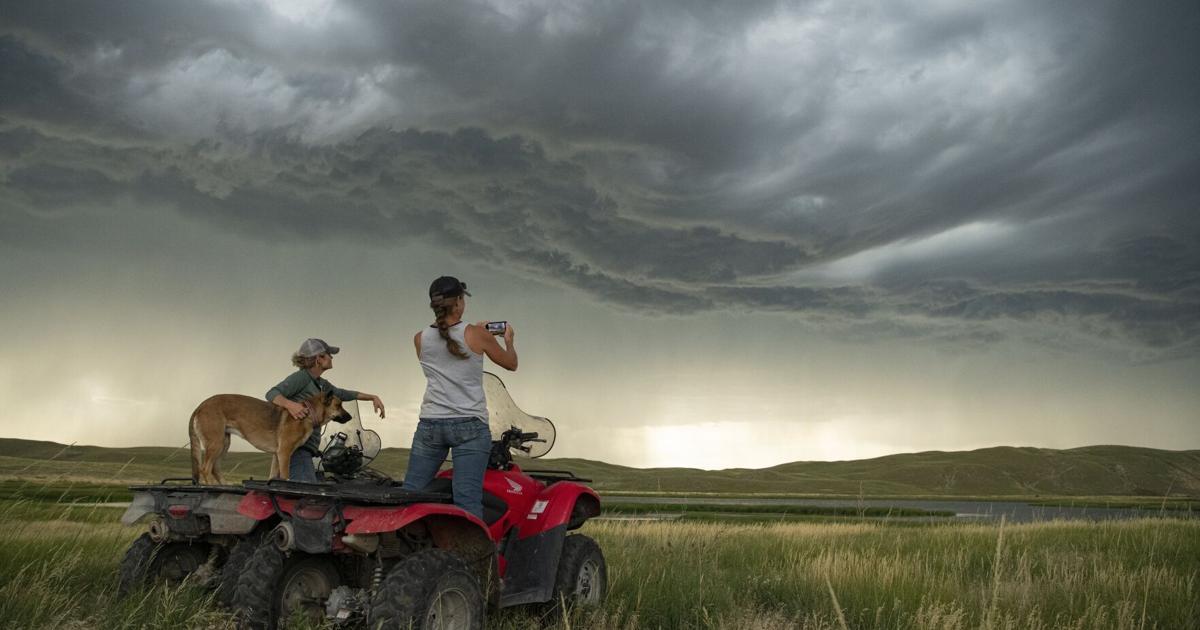[ad_1]
Joel Sartore celebrated two very visible milestones last month.
The Lincoln-based National Geographic photographer added his 14,000th species to the National Geographic Photo Ark, a project he founded in 2005 to document Earth’s biodiversity. The stunning Indochinese green magpie named Jolie, now at the Los Angeles Zoo and Botanical Gardens, was one of only eight birds — out of 93 — to survive a flight from Vietnam in a wildlife trafficker’s suitcases in 2017.
Twenty of Sartore’s photos of endangered species from the Photo Ark were featured on a panel of U.S. postage stamps released to commemorate the 50th anniversary of the Endangered Species Act. One, a piping plover, was photographed near Fremont, Nebraska.
People are also reading…
But Sartore and his wife, Kathy, also have been quietly working on a less visible conservation project.
Over about the past dozen years, the couple have purchased about 5,700 acres of what Joel Sartore called “conservation land” — pastureland dotted with marshes, lakes and native grasses that are home to thousands of birds in warm months — in southern Sheridan County in Nebraska’s Sandhills.
They partner with a local ranch family with a similar conservation ethos. Jaclyn and Blaine Wilson, the daughter-father pair who operate the nearby Wilson Flying Diamond Ranch, and another family member lease and run cattle on the grazeable acres. The Wilson ranch was awarded Nebraska’s first-ever Leopold Conservation Award by the Sand County Foundation in 2006.
“It’s a lovely place, and it’s something I feel like I can do for conservation in a way that Photo Ark doesn’t do,” Sartore said. “This is real on-the-ground stuff.”
He and his wife, he said, have financed the purchases themselves by working hard and saving their money over the years. Sartore is known for his frugality and hard work; as a youth in Ralston, he worked at gas stations and a record store, mowed lawns and cleaned aquariums. Early in their marriage, he said, the couple bought, fixed up and sold two small farms in the Lincoln area, doing much of the work themselves.
The couple plan to put the land in trust so it’s maintained at its current level of use by people who have been there for generations, Sartore said. They also want to protect its abundant water from people who might come calling from drier regions.
“It’s a lifetime of work, and this is what we ended up with,” he said. “If we can afford it, we’d love to do it again.”
They also have purchased a couple of smaller conservation properties in eastern Nebraska — two small farms, one near Bennet and the other near Ceresco, as well as a pasture near Valparaiso. They’ve implemented conservation measures on all three, instituting rotational grazing on the pasture, as well as restoring ponds and planting native grasses and wildflowers for birds and pollinating insects.
But the bulk of their conservation purchases, he said, have been in Sheridan County. They bought their first pasture in the area in about 2011. They added larger parcels in 2019 and 2022, according to Sheridan County Assessor’s Office records, purchasing a total of about 4,400 acres for approximately $3.56 million.
Sartore said the couple focuses on wet ground — land a rancher can’t make much of a living on but that yields big conservation returns, land that provides habitat for waterfowl and upland ground for long-billed curlews, a species in decline. It’s also less costly acre-for-acre than farmland.
“These are not places you buy if you really want to invest your money,” he said.
Jaclyn Wilson recalls getting an email from Sartore in March 2020, about the time COVID-19 was taking off. Wilson, a fifth-generation rancher, knew who he was. Her grandparents gave her family a National Geographic subscription for Christmas each year. Its arrival in the mail was a monthly highlight.
In his email, Sartore counted himself among Wilson’s biggest fans. She has been writing opinion columns for the Midwest Messenger, an ag-focused publication, for more than a decade.
Wilson invited him to visit the ranch, and Sartore spent several days there in August 2020. He brought a biologist, and they collected insects, identifying 100-some species, including some new to the Photo Ark and a beetle that previously hadn’t been found that far north.
“It was really cool stuff,” Wilson said.
She took him to the property he’d previously purchased, and he asked if there were similar properties available in the area. Sartore’s more recent purchases include Thompson Lake, which is known for waterfowl, and Snow Lake, which features waterfowl and curlews and also is known for salamanders.
Sartore recalled that he’d read a real estate listing about the salamanders, which mentioned them as a commodity that could be seined and sold for fishing bait.
He said Dan Fogell, a herpetologist and life sciences instructor at Southeast Community College in Lincoln, has identified them as a subspecies of the Western tiger salamander called the Gray tiger salamander. They’re usually found a bit farther north, Fogell told him, but they’ve been found in multiple places in the Sandhills as well.
Wilson said her grandparents emphasized conservation and passed down those lessons to later generations. They planted thousands of trees and adopted management practices that are now widely recommended. They raised game birds for release to enhance local populations and only cut hay at certain times of the year. The family also has worked to restore a wetland on its property. In recent years, the ranch has begun selling beef direct to consumers through its website.
Both the family and Sartore encourage scientists to study wildlife on their properties. One project, Wilson said, involved collecting sonar data on bat populations. Another researcher studied dung beetles. Sartore noted that the Nebraska Game and Parks Commission bands geese in the area each spring.
“It’s been really neat that we’ve been able to bridge that gap with some of the conservationists he works with,” Wilson said.
Sartore said he likes the Sandhills because it polices itself. Run too many cattle for too long, and it creates bare spots, or blowouts.
He said he doesn’t have to worry about the condition of the land where he has made his purchases. It was, and continues to be, managed by people who care.
But the family’s purchases offer a chance to keep the most beautiful places from being developed after they’re gone, he said. Many of natural areas where he collected tadpoles and crayfish as a kid in Ralston now are under concrete.
Sartore takes other conservation measures, too, including maintaining a pollinator garden at his Lincoln office, complete with signs explaining what it is and how to do it at home. The FAQ section on his website — joelsartore.com — includes tips on how anyone can help save species, from properly insulating their homes to conserve energy to cutting back on single-use plastic items like grocery bags.
“We just think nature needs a break, and it has to be intentional,” he said.
Meanwhile, Sartore, who’s nearing 61, continues what he calls his “day job” with Photo Ark, a job he wants to continue as long as he can. For many species, the photographs are the only vetted and accurate record of their existence. His son, Cole, now accompanies him on overseas shoots.
He said he may hit 15,000 species by the end of the year. Initially, he estimated that the project would come in around 12,000 species, based on the number in the world’s accredited zoos and aquariums at the time. But those have grown in number, and he’ll go anyplace animals are in human care, from fish markets to wildlife rehabilitation facilities. He could see the Ark possibly reaching 20,000 species.
“It’s meant to inspire (people to) want to save nature and save themselves at the same time,” he said.
Our best Omaha staff photos & videos of June 2023

A dog peaks out of a window and watches as police investigate a shooting near 30th and Hamilton Streets on Wednesday.

O.NE Finest dancers perform during a hometown send-off for Terence “Bud” Crawford ahead of his fight with fellow welterweight world champion Errol Spence on July 29. Photographed at B&B Sports Academy in North Omaha on Saturday.

Julia McGuigan, facing, demonstrates a drawing technique with student Anahi Salazar during an “Urban Illustration” workshop at her studio and shop north of downtown Omaha on May 12.

A woman is visible distraught after a forklift struck a propane tank and caused an explosion and blew the garage doors off of a building owned by Omaha Public Schools located at 4301 N 30th St. a on Monday. One person was seriously injured.

The Omaha fire department investigate the scene after a forklift struck a propane tank and caused an explosion at 4301 N 30th St. a on Monday. One person was seriously injured.

Some of the leather bags from Jared Hall’s 3am Luxury brand.

Omaha police investigate a shooting that injured one person near 30th and Hamilton Streets on Wednesday.

Omaha police and forensics investigators look for evidence as they investigate a shooting that injured one person near 30th and Hamilton Streets on Wednesday.

Police closed Hamilton Street near 30th to investigate a shooting early on Wednesday.

2023 All-Nebraska baseball team captains Millard South’s Cam Kozeal, left, and Omaha Gross’s Connor Capece pose for a portrait on Thursday.
[ad_2]




